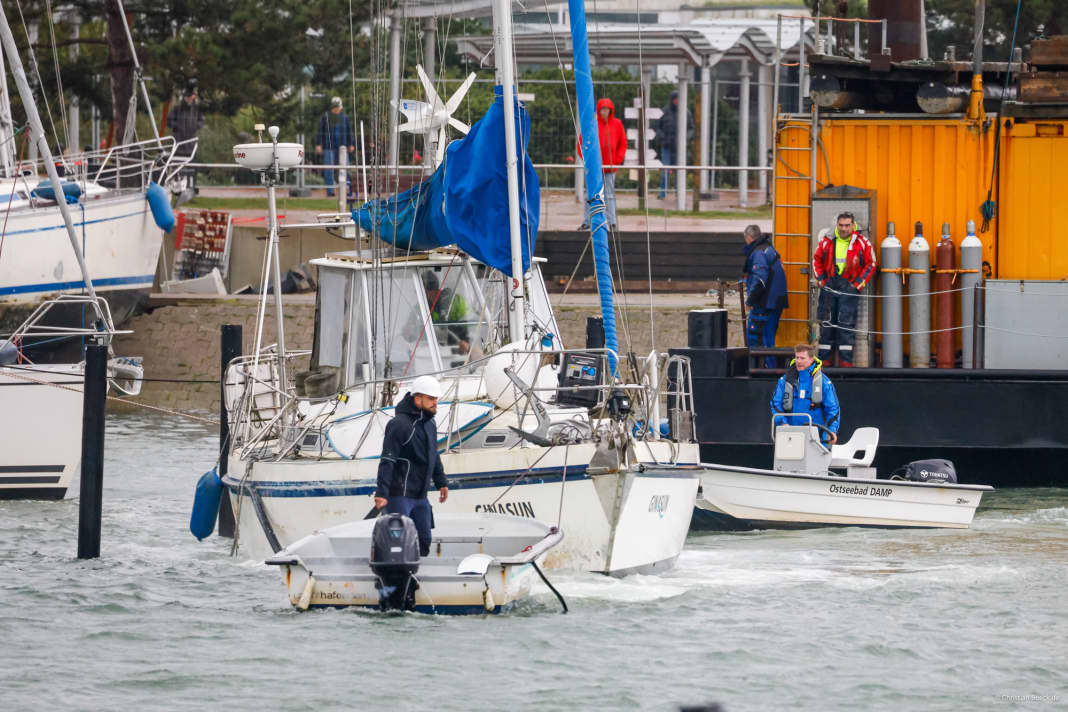





The salvage of the sunken yachts is nearing completion in Maasholm and Damp, while the salvage teams in Schilksee will probably continue working into the coming week. The official order, according to which the yachts in Kiel's harbours were to be salvaged by 31 October, has been extended. Over 50 yachts have been brought ashore so far. According to head of marketing Jonas Ball, the insurance broker Pantaenius alone is currently claiming over six million euros and this figure is likely to rise to over seven million. In total, the damage to boats alone, excluding destroyed infrastructure, is estimated at up to 30 million euros.
But for many owners, the scare is not quite over once the boat has been salvaged. What happens to boats that are slightly damaged or even a total loss?
Who is responsible for disposal?
In principle, the owner is responsible for repairs or, in the event of a total loss, for disposal. However, in view of the full order books at the shipyards in question, repairs are not easy and are usually expensive, more expensive than the sum insured, which makes the boat a total loss.
As in the case of Rainer Görge from Hamburg, an experienced cruising and regatta sailor, including in the 505. "I feel sunk," he says looking back on the night of the storm. His windward pilot had obviously failed to secure his yacht properly and it drifted onto his Wasa 360, contributing to the sinking. Although his boat was the first to be raised in Schilksee, it remained under water for around 60 hours. Although the engine was preserved, it needed a general overhaul, the electronics were scrap and there was a gaping hole in the hull.
He has now advertised the boat on Ebay classifieds and is at least hoping to realise a residual value. Which is not so unlikely. "Several people have already enquired, including a club that might want to repair the boat for the youth group," says Görge. A professional repair would exceed the insurance value for him.
The hunt for residual values
His boat is not the only one. There are currently a number of classified adverts for yachts that have suffered damage in the storm. The aim of the offers is to realise a residual value, depending on the damage. This is because the owner is obliged to keep the amount of damage as low as possible. Although he normally receives the fixed rate from the insurance company, the sale is an attempt to reduce the amount of damage for the insurer. If no offer is made, disposal is usually the only option.
However, some owners are overwhelmed by this procedure. Where do you get an expert opinion, how do you get the boat to the recycling company, and where can you find companies that can dispose of such large parts? There are few.
In the case of Pantaenius, those affected can take advantage of a service provided by the insurance broker. The broker tries to find contractors for yachts that still need to be repaired, organises the removal of the total losses to the disposal company and also tries to achieve residual values for the yachts. "Bundling the handling of the many claims makes higher residual values more likely," says Ball.
Other insurers, who sometimes do not have the necessary expertise themselves, commission experts to handle the process, such as the engineering and expert office Navitaz Solutions in Lübeck. They also already have a number of classified adverts. "However, the supply is currently greater than the demand," says Managing Director Hannes Häger. But even small sums or partial sales of certain equipment would help to reduce the loss for the insurer.
Pantaenius is also in the process of finalising the first valuations. They are also receiving many calls from prospective buyers.
Real bargains?
Total storm damage can actually be a bargain. Because even if a professional repair may not be worthwhile, some people can get a cheap boat by doing it themselves.
But be careful: The buyer is responsible for the removal and, if the intended project cannot be realised after all, also for the disposal. And this can quickly cost several thousand euros and significantly exceed the purchase price.
More about the Baltic Sea storm surge:
- Only minor problems for the charter season
- Huge damage to the infrastructure
- Over 200 total losses - "Schilksee resembles a battlefield"
- Will the insurance companies pay for the damage?
- On board - Experiences during the night of terror
- All yachts must be salvaged by 31 October
- Dramatic depiction of the night of horror

